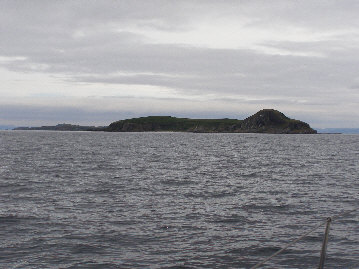

10: Campbeltown to West Loch Tarbert,
10th July
Shipping forecast, 10th July 12.01, Malin: Variable 4 becoming N 5 to 7 perhaps gale 8 later; rain; moderate or good, occasionally poor.
Campbeltown provides a good point of departure for rounding the Mull of Kintyre and heading north into the islands. The tide runs strongly round the Mull with the potential for dangerous overfalls in unsettled weather, and is the key consideration when planning this passage. It is best to leave Campbeltown with sufficient remaining south going stream then round the Mull on the slack so as to take the full run of the north going stream once bound north up the west side of the Kintyre peninsular. Sailing overnight is not an attractive proposition from here on with the more demanding navigation and pilotage required, though the main channels are lit so it is not impossible. The tides generally run quite strongly however, particularly as we were now on springs, and there are plenty of places to anchor, so our intention whilst on this section of the voyage, up through the islands, was to make daylight passages of six hours or so during the period of the favourable north going stream with a planned destination port or anchorage for each night at around the point at which we could expect to be by that time.

The gale blew hard that night and through much of the following day, with fierce gusts, but the location, opposite the ferry terminal at Kennacraig, provided adequate shelter (though it would have been better still further up towards the head of the loch) and the anchor held firm. Indeed the anchor dug itself in so hard that we couldn’t get it out when the time came to leave.
Unsurprisingly, being in the middle of nowhere, there was no mobile internet available. Carole didn’t like it on this account, she likes to get her e-mails, but I was perhaps more appreciative of the remote quality of the place, which we had entirely to ourselves, and certainly very appreciative of the shelter provided. Generally mobile internet coverage was much better than we had expected, and than reported previously by round Britain sailors. There was something nearly everywhere and broadband speeds in the majority of places we visited.
Looking at the possibilities for the first leg from Campbeltown, there is Ardminish on Gigha Island, twenty five miles north of the Mull, though it should be possible to get further than this with a spring tide helping. Further up, Lowlandman’s Bay, on the eastern side of Jura, or the small bay close south of it, would be about right but with the forecast of heavy weather coming in I wanted somewhere with better shelter, and also better holding if we were to ride out a gale there; Lowlandman’s Bay is reported as having poor holding with extensive kelp. The bay to the south has good holding but is exposed to northerly winds, the direction of the forecast bad weather. West Loch Tarbert looked like the best bet. It is well sheltered towards the top end, there is convenient depth for anchoring, and good holding in mud, so this was my choice. The disadvantage is, as with many of these sea lochs, you have to go right up to the top end to find shelter, a detour of about five or six miles in this case, and then come back down the next day, but you can’t have everything.
We cleared the entrance to Campbeltown Loch at 09.00 on the 10th June, took the inside passage between Sanda Island and the mainland and rounded the Mull shortly before noon, around HW Dover, to take the north going stream, and arrived to anchor at West Loch Tarbert at 17.30 hours having logged 43 miles.
Approaching Gigha Sound: Cara Island and beyond it Gigha Island seen from the south